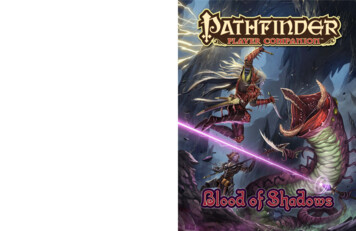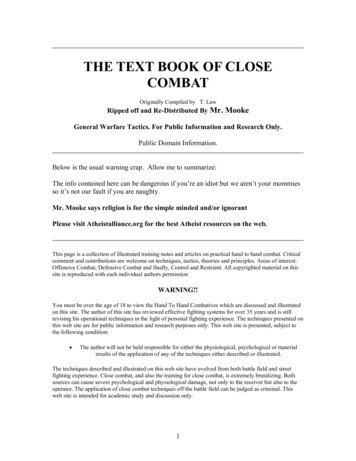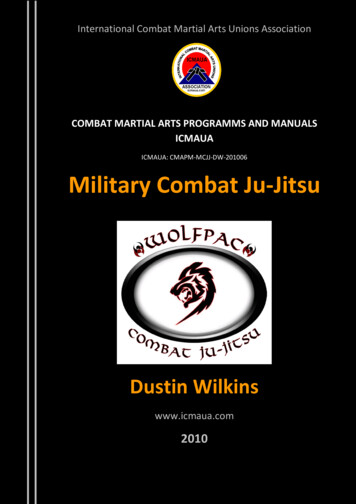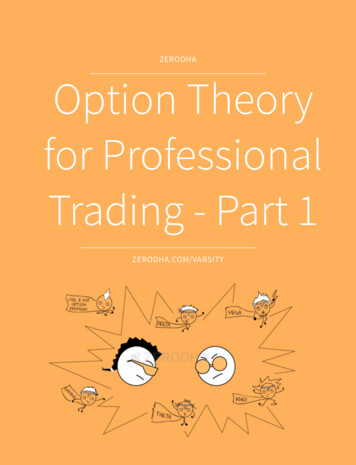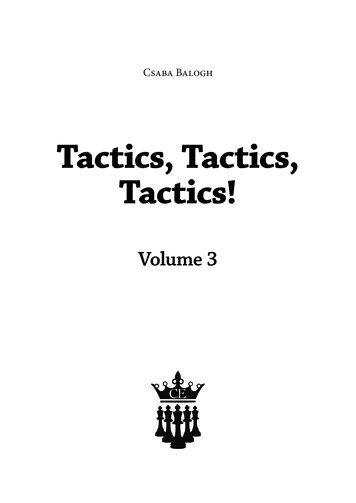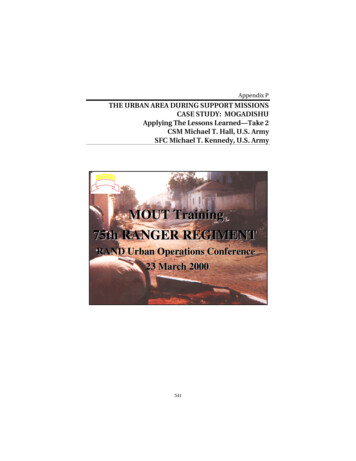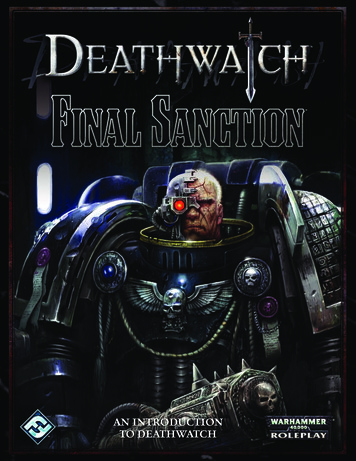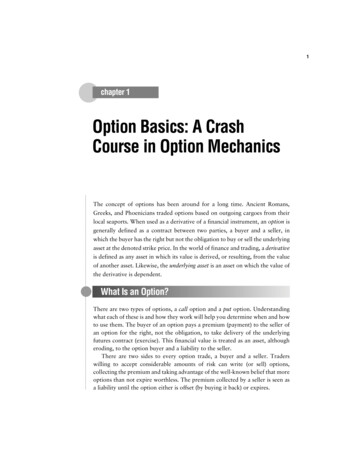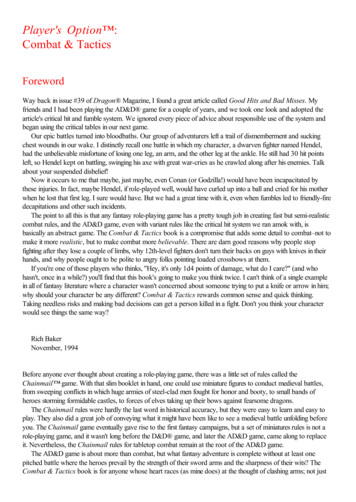
Transcription
Player's Option :Combat & TacticsForewordWay back in issue #39 of Dragon Magazine, I found a great article called Good Hits and Bad Misses. Myfriends and I had been playing the AD&D game for a couple of years, and we took one look and adopted thearticle's critical hit and fumble system. We ignored every piece of advice about responsible use of the system andbegan using the critical tables in our next game.Our epic battles turned into bloodbaths. Our group of adventurers left a trail of dismemberment and suckingchest wounds in our wake. I distinctly recall one battle in which my character, a dwarven fighter named Hendel,had the unbelievable misfortune of losing one leg, an arm, and the other leg at the ankle. He still had 30 hit pointsleft, so Hendel kept on battling, swinging his axe with great war-cries as he crawled along after his enemies. Talkabout your suspended disbelief!Now it occurs to me that maybe, just maybe, even Conan (or Godzilla!) would have been incapacitated bythese injuries. In fact, maybe Hendel, if role-played well, would have curled up into a ball and cried for his motherwhen he lost that first leg. I sure would have. But we had a great time with it, even when fumbles led to friendly-firedecapitations and other such incidents.The point to all this is that any fantasy role-playing game has a pretty tough job in creating fast but semi-realisticcombat rules, and the AD&D game, even with variant rules like the critical hit system we ran amok with, isbasically an abstract game. The Combat & Tactics book is a compromise that adds some detail to combat–not tomake it more realistic, but to make combat more believable. There are darn good reasons why people stopfighting after they lose a couple of limbs, why 12th-level fighters don't turn their backs on guys with knives in theirhands, and why people ought to be polite to angry folks pointing loaded crossbows at them.If you're one of those players who thinks, "Hey, it's only 1d4 points of damage, what do I care?" (and whohasn't, once in a while?) you'll find that this book's going to make you think twice. I can't think of a single examplein all of fantasy literature where a character wasn't concerned about someone trying to put a knife or arrow in him;why should your character be any different? Combat & Tactics rewards common sense and quick thinking.Taking needless risks and making bad decisions can get a person killed in a fight. Don't you think your characterwould see things the same way?Rich BakerNovember, 1994Before anyone ever thought about creating a role-playing game, there was a little set of rules called theChainmail game. With that slim booklet in hand, one could use miniature figures to conduct medieval battles,from sweeping conflicts in which huge armies of steel-clad men fought for honor and booty, to small bands ofheroes storming formidable castles, to forces of elves taking up their bows against fearsome dragons.The Chainmail rules were hardly the last word in historical accuracy, but they were easy to learn and easy toplay. They also did a great job of conveying what it might have been like to see a medieval battle unfolding beforeyou. The Chainmail game eventually gave rise to the first fantasy campaigns, but a set of miniatures rules is not arole-playing game, and it wasn't long before the D&D game, and later the AD&D game, came along to replaceit. Nevertheless, the Chainmail rules for tabletop combat remain at the root of the AD&D game.The AD&D game is about more than combat, but what fantasy adventure is complete without at least onepitched battle where the heroes prevail by the strength of their sword arms and the sharpness of their wits? TheCombat & Tactics book is for anyone whose heart races (as mine does) at the thought of clashing arms; not just
hack 'n slash, but heroic battles with swirling action, ringing steel, and eldritch flashes of magic. You won't find 20pages of tables telling you exactly where a sword blow lands in this book, but you will find plenty of ways to makecombat more than a dice-rolling contest or an exercise in subtracting hit points from your character's total. If alongthe way you learn to stay away from fights unless you're sure your party can win them, that's even better.Skip WilliamsNovember, 1994Table of ContentsChapter One:Player's Option Combat SystemDoes This Belong in My Campaign?The Battle MapFigures and FacingScaleMelee ScaleRangeWeaponsMonstersMissile ScaleSwitching ScaleCombined ScaleThe Combat RoundCombat Rounds andGame TimeSpell DurationsCombat StatusClearThreatenedUnusual Monsters and ThreateningGrappledAttacks of OpportunityMovementBase MovementExceptional Abilitiesand MovementStrengthDexterityEncumbranceSimplified EncumbranceOpening the BattleSurpriseEncounter DistanceSet-upThe Five Basic Steps of Every Combat RoundStep One: Monster Action DeterminationStep Two: Player Action Declaration
Step Three: InitiativeStep Four: Resolution of ActionsStep Five: End of Round ResolutionInitiativeThe Initiative RollBase InitiativeWeapon SpeedsCritical EventsCombat ActionsCombat Actions and MovementNo-Move ActionsHalf-Move ActionsFull-move ActionsMovement and InitiativeCombat Movementon the Battle MapMoving Through Other Figures in CombatOverrunsChoosing an ActionThe ActionsAttackCast a SpellChargeCoverFire/Throw MissilesGuardMoveParryRunSprintUnarmed CombatUse A Magical ItemWithdrawEnding the Combat RoundRetreatsFatigueKeeping Track of FatigueEffects of FatigueRecovering from FatigueEffects of Force Marching on FatigueMoraleInformal Morale ChecksFormal Morale ChecksFailing a Morale CheckStatusSpecial Combat ConditionsStandard and OptionalAD&D RulesMovement and FootingCover and ConcealmentMounts
Rear or Flank AttacksSitting, Kneeling,and Lying ProneDamage and DyingWeapon Type vs. Armor TypeFiring Into a MeleeAdditional RulesHigher GroundKnockdownsCritical HitsThe Gray AreasExample of CombatRound OneRound TwoRound ThreeRound FourChapter Two:Combat OptionsDoes This Belong in My Campaign?Battle TacticsShield WallVersus MissilesVersus MeleeSpear HedgesMounted ChargeArchery from HorsebackAttack OptionsThe Opposed RollBlockCalled ld-RushSpecial Weapon ManeuverTrapTrap and BreakUnarmed AttackUnhorseFighting StylesSingle WeaponTwo-handed WeaponSize and Two-handed WeaponsOne- or Two-handed WeaponsOne-handed Weapons
used Two-handedWeapon and ShieldTwo WeaponUnarmedMissile or Thrown WeaponMultiple Loaded WeaponsThrown WeaponsWeapon-Specific StylesDuelingWhat's A Duel?InitiativeThe Dueling PlotAttacking in the Right SpotReading an Opponent's MoveMoving the FiguresChoice of DefenseChoice of AttackEnding a DuelHeroic FraysChapter Three: The BattlefieldDoes This Belong in My Campaign?BattlefieldsThe Four Basic BattlefieldsDungeons or CavesTown or BuildingOutsideCastles or FortificationsBattlefield CharacteristicsEncounter RangeLines of FireCover and ConcealmentFootingObstaclesUnusual Materials or HazardsTerrain TypesBadlandsCavesDesertFields or FarmlandForest, Heavy or JungleForest, n Streets
Generating a BattlefieldStep One: ScaleStep Two: TopographyFlatHillyBrokenSlopes and EscarpmentsStep Three: Ground Cover and WaterClearThicketsLight WoodsHeavy WoodsClearBogStreamPondStep Four: ObstaclesStep Five: Putting It All TogetherFighting in Unusual ConditionsLimited VisibilityMoonlight or Moderate Fog or RainStarlight or Dense Fog or Heavy RainTotal DarknessWaterWeapon RestrictionsVisionMovementFighting Underwater Monsters From the SurfaceClimbingMovementFightingFighting Flying CreaturesAerial CombatInitiativeThreateningMovementAttacks from BelowAttacks from AboveUnseating a RiderCombat on Other PlanesAstral CombatEthereal CombatThe Effects of Magic on the BattlefieldWizard SpellsPriest SpellsMagical ItemsChapter Four: Weapon Specialization & MasteryWeapon ProficienciesIntelligence and Proficiencies
Proficiencies and theWeapon GroupsSpecialization andWeapon GroupsCharacter Classes and Weapon ProficienciesKits and Barred WeaponsNew WeaponsShield ProficiencyArmor ProficiencyWeapon seSpecializationMelee WeaponsMissile WeaponsBowsCrossbowsFirearmsWeapon MasteryEffects of MasteryHigh MasteryGrand MasterySpecial DM NoteFighting Style SpecializationsWeapon and Shield StyleOne-handed Weapon StyleTwo-handed Weapon StyleTwo-Weapon StyleMissile or Thrown Weapon StyleHorse ArchersLocal Fighting StylesSpecial TalentsChapter Five:Unarmed CombatDoes This Belong in My Campaign?BrawlingBrawling Attacks Against Armed OpponentsTemporary DamageOpposed RollsPummelingPummeling ProceduresPummeling Skill LevelsAn Example of PummelingSpecial Pummeling ManeuversSappingKickingWrestling
Wrestling ProceduresHoldsPreviously Established Holds and LocksBreaking FreeAssistanceLocksWrestler Versus WrestlerWrestling Skill LevelsAn Example of WrestlingOverbearingOverbearing ProceduresPinsEffects of PinsMaintaining and Breaking PinsAssistanceOverbearing Skill LevelsAn Example of OverbearingAttack Options andUnarmed AttacksSubdual AttacksAn Example of SubduingMartial ArtsMartial Arts ProceduresMartial Arts Skill LevelsMartial Arts WeaponsAn Example of Martial Arts CombatMartial Arts TalentsChapter Six:Critical HitsDoes This Belong in My Campaign?Critical Hits: System ICritical Hits: System IICritical Hit ChartsLocationSeverityResistanceReading the Critical Hit TablesSpecific InjuriesCritical Hit EffectsCritical Hit TablesChapter Seven:Weapons & ArmorEquipment GroupsReading the Equipment ListsStone Age or Savage CulturesTools/CommonThe Bronze Age and Ancient Cultures
RomanDark AgesThe CrusadesHundred Years' WarThe RenaissanceMiddle EasternOrientalFirearmsArmorMaster Weapon ListWeapon DescriptionsWeapons TablesWeapon GroupsWeapons and Ability BonusesArmor DescriptionsChapter Eight:Siege WarfareDoes This Belong in My Campaign?War MachinesBombardment rdment EngineProceduresIndirect Fire EnginesAn Example of IndirectBombardmentDirect Fire EnginesAn Example of DirectBombardmentVehiclesChariotHowdahCarrying Capacities For BeastsWagonDriving Checks and Flipping OverRammingMiscellaneous War MachinesBattering RamBoreCauldronGallery ShedGreek Fire ProjectorMantlet/AbatisRam CatcherRocks
Critical Hits andKnockdown DiceMultiple TargetsSiege TowerEscaladesThe Approach of A CastleWallsWall DefensesScaling WallsLaddersGrappling HooksWar Machine vs. War MachineFiresSappingPetardsCreatures InsideDestroyed TargetsMagical AttacksSiegesReductionReduction ProceduresSaving Throw FailureMinesCounter MiningInvestmentMass CombatMass Combat ProceduresAn Example of Mass CombatProficienciesChapter Nine:MonstersDoes This Belong in My Campaign?Creatures in BattleIntelligenceAlignmentMoraleCreature TypesHumanoidAnimalMonsterAttack and Armor TypesAttacksArmorIndex
CreditsDesign: L. Richard Baker III & Skip WilliamsEditing: Thomas M. ReidProject Coordinator: Steve WinterArt Coordinator: Peggy CooperCover Illustration: Jeff EasleyInterior Illustrations: Doug Chaffee, Les Dorscheid, Larry Elmore,Ken & Charles Frank, Roger Loveless, Erik Olson, and Alan PollackGraphics Coordinator: Paul JaquaysGraphic Design: Dee BarnettProduction: Paul HanchetteTypography: Angelika LokotzPhotography: Charles KohlDiagrams: Paul HanchetteSpecial Thanks: Dave GrossAdvanced Dungeons & Dragons, Dungeons & Dragons, AD&D, D&D, Dungeon Master, Dragon Strike, andDragon are registered trademarks owned by TSR, Inc.Chainmail, Monstrous Manual, Planescape, Player's Option, and the TSR logo are trademarks owned byTSR, Inc.This book is protected under the copyright laws of the United States of America. Any reproduction or otherunauthorized use of thematerial or artwork contained herein is prohibited without the express written permission of TSR, Inc.Random House and its affiliate companies have worldwide distribution rights in the book trade for English languageproducts of TSR, Inc.Distributed to the book trade in the United Kingdom by TSR Ltd. Distributed to the toy and hobby trade byregional distributors. 1995 TSR, Inc. All Rights Reserved. Printed in the U.S.A.0–7869–0096–22149XXX15012nd Printing, Nov 1995.Chapter One:Player's Option Combat SystemThis chapter introduces the Player's Option combat system, an advanced set of skirmish rules designed to adddetail and flavor to battles in an AD&D game. The combat rules from the Player's Handbook and DungeonMaster Guide have been expanded and streamlined to create more active, exciting battles.In most forms of personal combat, there is a lot more going on than a cycle of swing-and-miss andswing-and-hit actions. In a fight, people move around. They press advantages or fall back when they need to getsome room. Consider a pair of boxers. They're not just throwing punches; they're ducking, dodging, weaving, andtrying different attack strategies such as jabs, hooks, or uppercuts.Armed combat is much the same. Position is important. Enemies try to surround lone characters to get flank orrear attacks. Large creatures such as giants or dragons use their bulk to knock smaller opponents back and scatterdefenses. These are not unusual attacks or special maneuvers; they're things that just happen in the chaos of a fight.
The Player's Option combat system incorporates these effects and tactics, making them available for heroesand monsters both. Your battles will never be the same again.Does This Belong in My Campiagn? The Player's Option combat system is an integrated set of rules thatdovetails with the later chapters in this book. However, you don't have to use this chapter in order to make use ofthe other systems.This chapter presents several new combat actions, restructures the AD&D initiative system, and introducesretreats, fatigue, and critical events. Most of the material assumes that you will use these rules with character andmonster miniatures on some kind of map. If you don't want to run combat like this, you'll still find that the newinitiative system and actions can be used without any figures or maps at all.The Battle Map The Player's Option combat system is played on a gridded battle map with 1-inch squares.The battle map becomes a diagram of the battlefield that can be used with figures, stand-up counters, or markers.The exact location of each character or creature is important, since facing and terrain are critical to the tactics of afight.A number of games and accessories, such as the Dungeons & Dragons Adventure Packs, include griddedmaps. Feel free to borrow mapboards and modify them for use in your own campaign.You can also use dry-erase boards, magnetic dungeon tiles, or washable gridded mats to portray yourbattlefield. You can make your own maps to customize the battlefield for each combat. In fact, it's a good idea forthe DM to prepare for an encounter by making a map of the battlefield beforehand. As long as the map is markedin 1-inch squares, it will do.Some DMs and players may prefer battle maps marked with hexes instead of squares. Hexes, however,introduce certain inconveniences to the rules that do not surface with a square grid. (For example, can figuresoccupy partial hexes near walls?) Nevertheless, with a few modifications it is certainly possible to adapt thePlayer's Option combat system to a hex grid.Figures and FacingEvery character in a fight is represented by a miniature, stand-up, or marker of some kind. Figures show thelocation of every creature in the battle and also show the facing of each creature. In melee scale, one Man-sizedcreature fills one square on the map.In any fight, facing is very important. It's hard to punch someone standing behind you unless you turn around.Each figure or marker on the battle map should have an obvious front facing. For miniatures in strange poses,everyone should agree beforehand what direction is the front of figure. "This figure faces the square his sword ispointing at" is good enough.All figures have front, flank, and rear spaces. The three spaces in front of a figure are its front spaces, the twospaces directly beside it are flank spaces, and the three spaces behind it are rear spaces. Facings can be at the sideof a square or at the corner (see diagram).Normally, characters can only attack enemies in their front spaces and gain attack bonuses when they attack anenemy's flank or rear.There are two situations where more than one figure can occupy a single square: grappled figures are both in thedefender's square, and characters in close order (see Chapter Two) can fit two figures to a single square. If there ismore than one figure in a square, each figure has the same front, flank, and rear spaces; no one is considered to bein the left side of the space, or the back of the space, or whatever.Tiny (Size T) creatures can fit an unlimited number in one square, although it would be unusual for more than 10to be in one space unless they were insect-sized.Figures that are smaller than Man-sized (Size S) normally occupy one square each, but if space is tight they'llfight two to a square with no penalty. Small creatures in close order can fit three figures in a square.Large (size L) creatures normally occupy one space on the map. They can fight in close order simply byoccupying adjacent spaces.Huge (size H) creatures occupy two to four spaces on the map, depending on their size and shape. Humanoidssuch as giants and ettins are two squares wide, creating an extra front space and an extra rear space. Horse-like or
serpentine creatures have a narrow front and a long body, creating two extra flank spaces. Block-like or massivecreatures occupy a four-space square.Gargantuan (Size G) creatures occupy at least six spaces. They can be even bigger if the DM decides that thecreature's proportions are truly immense. A dragon with a 40-foot body could take up a block of spaces two wideand eight long! Gargantuan creatures define front, flank, and rear spaces so that roughly one-third of the adjacentsquares fall into each category.
Scale In normal combat situations, each 1-inch square on the map represents an area 5 feet square. This isreferred to as melee scale. Under certain special circumstances, each 1-inch square can represent 5 yards. This isknown as missile scale.Melee ScaleThe melee scale is the default scale for battles that take place indoors, inside dungeons, in darkness or fog, or atclose range. As long as the combatants are all starting within 50 or 60 yards of each other, most battle maps arebig enough to run in melee scale from the start. This will save you the trouble of converting from missile scale tomelee scale during the battle (see Missile Scale, below).In melee scale, remember that spell and missile ranges are based on yards, not feet. A thrown dagger normallyhas a short range of 10 yards, or 30 feet. In melee scale, this is 6 squares on the battle map. A spell with a 30-yardrange can be targeted 18 squares away.RangeMost characters and monsters can only make melee attacks against creatures standing in one of their front spaces.However, some weapons provide extra reach for characters, and some monsters cover a greater area because ofsize.WeaponsMany polearms are assigned a range, much like missile weapons. A polearm with a range of 2 can strike enemiesstanding in the character's front square or any adjacent square beyond the row of front squares.Some weapons are defined as range only weapons. Pikes and lances fall into this category. These weaponscan be used to make normal attacks in the squares they can reach but cannot be used against targets in betweenthe wielder and the weapon's point.
Creatures wielding range 2 or larger weapons or natural attack forms cannot make melee attacks through anoccupied square to another square unless as part of a spear or pike hedge (see Chapter Two).MonstersAny Large creature armed with a weapon adds 1 to its range, due to its great natural reach. For example, an ogrewielding a spear (normally range 1) has a range of 2 with the weapon. Any Huge creature armed with a weaponadds 2 to the weapon's range. A Gargantuan creature adds 3 to a weapon's range; a titan swinging a 15-footsword endangers an enemy quite a ways off.Some monsters may also have natural attacks that allow them to strike opponents at ranges greater than 1.Missile ScaleSome battles may open in missile scale, which is five yards to the square. The only reason to set up a battle inmissile scale is when the two hostile forces try to engage each other with spells or missiles at ranges greater than 50yards or so. Naturally, this usually happens in outdoor settings with good visibility. If neither side has any missile orspell capability, there is no reason to set up the battle in missile scale. Save yourself the trouble of converting andset it up in melee scale from the start.For example, the heroes encounter a party of orcs while climbing a high mountain pass. The DM decidesthat the two groups spot each other at a range of 500 yards, since there isn't much cover. Nothing happensuntil the groups close to 210 yards, since that is the maximum range of the party's longbows. The DM tellsthe players that they begin the battle in missile scale, 42 squares away from the orcs.In missile scale, characters and monsters move 1/3 as fast as normal. A character that could normally move 12squares in a combat round can only move four spaces per round in missile scale. There are nine melee squares in asingle missile square, so up to nine Man-sized creatures can occupy a square when missile scale is in effect.Since all spell and missile weapon ranges are expressed in yards, it is easy to figure ranges in missile scale. Atarget eight squares away is actually 40 yards distant.Switching ScaleWhen two opposing creatures move adjacent to each other, it's time to switch the scale from missile to meleescale. Select one figure as an anchor, and move all the other figures three times as far from the anchor as theywere. In effect, you're zooming in on the battle.An easier but less accurate method of zooming in on the battle is to simply announce that you're switching scaleand allow both players and monsters to get a second set-up. As long as everyone sticks by the spirit of the set-up,just eyeball it. Make certain that the opposing forces have three times as many squares between them as they didbefore the scale was zoomed in.Combined ScaleA handy way to keep track of where the party members are in relation to each other is to have them set up theirmarching order in melee scale. Set up the monster group in melee scale in relation to each other. Now, assume thatall the spaces between the party and the monsters are missile squares. Make sure you indicate where the scalechanges by setting a pencil or ruler on the map.This combined scale method assures that monsters trying to close under missile fire have to withstand the normalamount of attacks before they get close enough for melee. It's also useful for determing the areas of effect of anyspells cast at the opposing group. When any two opposing characters come in contact, switch the scale.
The Combat Round In a standard AD&D game, rounds are assumed to be about one minute long. Thecombat system round lasts about 10 to 15 seconds, during which a typical swordsman will make about three to sixswings. Most characters and monsters can only make one effective attack in this time; the rest of the swings arefeints, parries, or just for show.Higher-level characters with multiple attacks are able to make more of these swings count. Parries are followedup with ripostes. Feints suddenly become attacks when an opening presents itself. With time and practice, a skillfulswordsman can make every swing of his sword a potentially lethal attack.Combat Rounds and Game TimeCombat rounds replace the one-minute round in normal AD&D combat situations. If you need to keep count, fivecombat rounds equal one normal round, and 50 equal a full turn.To make things easy, the DM can rule that a battle, regardless of its actual length, takes one turn. Characterstend to spend several minutes checking on fallen enemies, surveying their own injuries, and making sure that theenemy has abandoned the field before dropping their guard. Unless time is an issue, this is reasonable.Spell DurationsAll spells with durations expressed in rounds last for the exact same number of combat rounds. Spells withdurations measured in turns last for the entire battle. If a spell measured in rounds is in the middle of its durationwhen the fighting begins, the balance of its duration runs in combat rounds.For example, a 5th-level mage casts a haste spell that lasts three rounds, plus one round per level, for atotal of eight rounds. In the fifth round, the party gets into a fight. The haste spell lasts four combat roundsbefore expiring.
Everything else about the spell still functions on a round-by-round basis, as it did before. A cleric casting heatmetal still inflicts 2d4 points of searing damage in the third, fourth, and fifth combat rounds. A wizard with afeather fall spell still falls at a rate of 120 feet per combat round. Remember, this is an abstract system; applyingphysics properties to every situation (such as the fact that the wizard with feather fall is now plummeting to theground at a hasty 6.8 mph rather than the standard 1.4 mph) may reveal lots of facts, but it won't make for a bettergame.Combat Status Any figure involved in combat falls into one of three categories: clear, threatened, orgrappled. This represents the immediacy of an enemy threat and influences what actions the character can choosefor that combat round. A character's options are extremely limited when he is caught in an owlbear's hug.In addition to governing the character's choice of combat actions for the round, threatening is also importantbecause it determines who is subject to what are known as attacks of opportunity (see below).ClearCharacters who are standing free of the melee and aren't endangered by any adjacent monsters are consideredclear. (The character can still be attacked by missile fire, charged, or have a spell thrown at him, of course.) Aslong as a character is not in the threatened spaces of any enemy figure, he is clear. The character's choice ofcombat action is unrestricted.Characters who are clear are allowed to turn to threaten a figure that moves up to them in the course of acombat round. The character doesn't have to do this; he can ignore the danger. The character only gets this freefacing change once per round, so he can elect to threaten the first figure that moves up to him or to wait upon thearrival of a more dangerous enemy.ThreatenedAny square that a creature can reach with its weapons or claws also threatens those squares and therefore anycharacters or creatures standing in one of the threatened squares. The character's own facing doesn't matter–it'spossible to be threatened by someone standing behind you.Threatened characters can choose to ignore the creature threatening them and take any combat action theywish, but if they do, the threatening creature gains an immediate attack of opportunity. The following actions createan attack of opportunity for the threatening creature: Attempting missile combat (other than at the threatening creature, and only in the combat round when it firstthreatens the character).Moving away from the threatening creature. This includes move, charge, and run, but not withdraw.Turning so that the threatening creature is now in a rear square.Attempting an unarmed attack against any foe except an unarmed human-like creature.1 Monsters and characters threaten all eligible squares throughout the entire round. If a character tries to sprintthrough the threatened squares to get by the defender, the defender gets an attack of opportunity as the characterruns by. If the creature being attacked suffers from a successful knockdown roll or if a critical hit from the attack ofopportunity is suffered, then it must stop moving. Otherwise, it may run by the creature threatening it.2Unusual Monsters and Threatening3There are a number of creatures that do not have a clear front facing. Who can tell what the dangerous end of anochre jelly or otyugh is? These amorphous monsters don't have rear or flank spaces, and therefore threaten anycharacter who moves next to them.
45Grappled6Grappled characters are physically restrained by their foes. There are a number of ways to grapple with anopponent; wrestling, martial holds, pinning, and grabbing are all possible. In addition, some monsters have specialattacks that grapple their victims. For example, a giant scorpion can pin its prey in its claws, or an owlbear can huga victim.7 Grappled creatures must get free before they can move. The only combat actions a grappled creature can takeare:8 Respond with unarmed combat.9 Attack the grappling creature with a size S weapon.10 Attempt to escape. Each grappling method defines a means of escape.11 Grappling creatures occupy the same square on the battle map, unless there is something unusual about themonster doing the grappling. For example, a roper can grapple characters up to 10 squares away with its specialtentacle attack.12 Grappling figures never threaten other squares.13Attacks of Opportunity14Attacks of opportunity occur when a threatened character or creature ignores the enemy next to it or turns itsback on a foe. The threatening enemy gets to make an immediate melee attack (or sequence of attacks formonsters with multiple attacks) against the threatened creature. Attacks of opportunity cannot be performed withmissile weapons. This is a free attack that does not take the place of any actions the threatening creature hadalready planned.15 A creature can't make more than one attack of opportunity against a single opponent in the course of a combatround, but if severa
The Combat & Tactics book is a compromise that adds some detail to combatýnot to make it more realistic, but to make combat more believable. There are darn good reasons why people stop fighting after they lose a couple of limbs, why 12th-level fig
